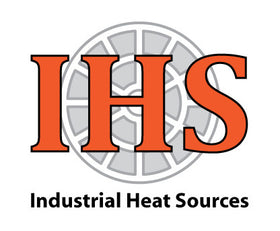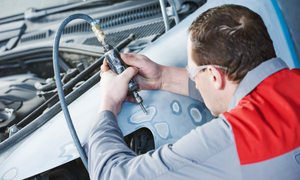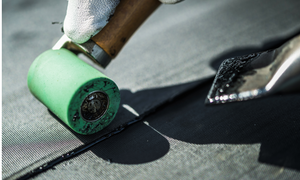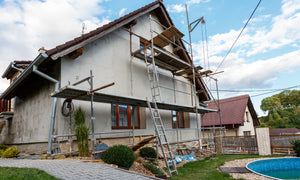How Plastic Welding is Used in Autobody Repairs

When it comes to autobody repairs, plastic welding is a surefire solution. Why?
Modern vehicles contain a significant amount of plastic, from bumpers to fenders, headlights, and interior panels. Traditional repair methods often involve replacing these plastic parts entirely, but plastic welding offers an alternative that’s both cost-effective and environmentally friendly.
Below, discovers how plastic welding is used in autobody repairs, the process involved, the materials it’s compatible with, and why it’s a popular option for repair professionals.
>>Related read: How to Execute the 4 Most Common Types of Plastic Welds
Why Plastic Welding is Important in Autobody Repairs
Vehicles today use more plastic than ever before. According to estimates, over 50% of the volume of modern cars is composed of plastic components. These materials contribute to reducing the overall weight of the car, improving fuel efficiency, and providing flexibility in design. However, plastic components are prone to damage in collisions, scratches, and general wear and tear. Traditionally, damaged plastic parts were replaced, leading to higher repair costs and increased waste.
Plastic welding provides an alternative that not only saves costs but also offers a reliable, long-lasting repair. By fusing broken plastic parts back together, this process restores the structural integrity and appearance of the damaged component. As a result, components can be repaired instead of replaced, benefiting the environment and cutting costs.
How Plastic Welding Works in Autobody Repairs
Thermoplastic hot air welding is the process of bonding plastic components together by using a hot air hand tool to heat and melt the edges of the materials being welded, allowing them to fuse together. The process can vary depending on the type of plastic and the type of hot air hand tool being used, but the basic steps remain consistent. They include:
- Identify Plastic Type: Before beginning any repair, it is essential for a technician to identify the type of plastic being welded. Different plastics have such as polyethylene (PE) or polypropylene (PP), have varying melting points and require specific temperature ranges for welding. Each type of plastic material has a unique composition, so choosing a compatible welding rod and welding method is also crucial for a successful repair. For example, if polyethylene (PE) plastic parts are being repaired, then a polyethylene welding rod is also required to execute a successful hot air weld.
- Preparation: Once the type of plastic is identified, the next step is to prepare the surface. This involves cleaning the area to remove surface oxidation, oils, and other contaminants, that might interfere with the welding process. Damaged or cracked edges are trimmed and beveled with a IHS - Stick Beveler Scraper to create a smooth surface that will bond correctly and ensure a strong weld.
-
Welding: Using a plastic welding tool like the HSK APX 300, 120V & 230V Hot Air Tool, the technician applies heat to the edges of the broken part and the welding rod. As the plastic melts, a bead of molten plastic (welding rod) is placed on and/or within the crack or break being repaired. The technician must apply the correct amount of heat to avoid overheating plastic material. For example, if the plastic materials are overheated, then the molecular properties will be ‘burned out’ of the plastic, which will make the plastic material un-weldable. Overheating can also cause the part to become deformed. Once the part has been deformed (warped), then the part can no longer be used.
For thicker plastic parts, such as bumpers, multiple layers (beads) of welding rod may be required to ensure a strong bond. When reheating previous layers, it is important to be sure that the hot air tool is calibrated to the correct welding temperature so that previously welded plastic material retains its molecular properties. Once the welded layers have cooled sufficiently, then a permanent molecular bond is achieved.
- Finishing: After the weld has cooled, the area is sanded and shaped to match the original contour of the part. If necessary, the repair can be further reinforced with adhesive and/or mesh material on the opposite side of the welded surface. Finally, the surface is smoothed out, primed, and painted, resulting in a seamless repair.
>>Related read: 10 Tips for Successfully Welding Plastics
Common Plastic Welding Applications for Autobody Repairs
Plastic welding is used in a variety of autobody repairs, particularly on parts that are difficult or expensive to replace. Some of the most common applications include:
- Bumper repairs: Automotive bumpers are fabricated using flexible thermoplastics like Acrylonitrile Butadiene Styrene (ABS) or Polycarbonate (PC), making them prone to cracks and dents in minor accidents. Instead of replacing the entire bumper, technicians can use plastic welding to repair these damages.
- Headlight and taillight housings: Vehicle headlight and taillight assemblies are fabricated using Polycarbonate (PC) plastic. These plastic housings can crack or break during accidents or when servicing the vehicle. Plastic welding can repair and restore their structural integrity without the need for costly replacements.
- Interior components: Interior components such as dashboards, door panels, and other plastic interior parts are fabricated using Polyvinyl Chloride (PVC) and Acrylonitrile Butadiene Styrene (ABS) plastics, which can suffer from cracks or damage over time. Welding is often the preferred method for repairing these components, as it preserves the original material and appearance.
- Engine components: Engine components such as air filter housings, coolant tanks, windshield washer fluid tanks, etc., are fabricated using High-Density Polyethylene (HDPE) and Acrylonitrile Butadiene Styrene (ABS) plastics. Plastic welding is used to repair cracked or broken parts, which have been damaged in an accident or during the repair of the vehicle. Component repair is often found to be a more cost-effective alternative to replacement of these parts.
Advantages of Plastic Welding for Autobody Repairs
Plastic welding autobody repairs offers several benefits over traditional repair methods, including:
- Cost savings: Replacing damaged plastic parts can be expensive, especially for high-end or specialty vehicles. Plastic welding allows repairs to be completed at a fraction of the cost.
- Environmental impact: By repairing rather than replacing plastic parts, plastic welding reduces the demand for new materials, lowering waste and conserving resources.
- Durability: When done correctly, plastic welding provides a strong, durable bond that can restore the part to its original condition.
- Efficiency: The process is often quicker than waiting for replacement parts, allowing for faster turnaround times in repair shops.
This technique not only extends the life of plastic components but also helps repair shops offer a cost-effective, eco-friendly solution for vehicle owners and insurance companies.
>>Related read: Top 6 Environmental Benefits of Thermoplastic Welding in Manufacturing
Elevate Your Autobody Repairs with These Plastic Welding Tools
When it comes to autobody repairs, you need the best tools to create the strongest welds. Explore our collection of vehicle repair hot air tools and accessories here, and reach out if you have any questions about which ones are right for you.

- Robert Heater






